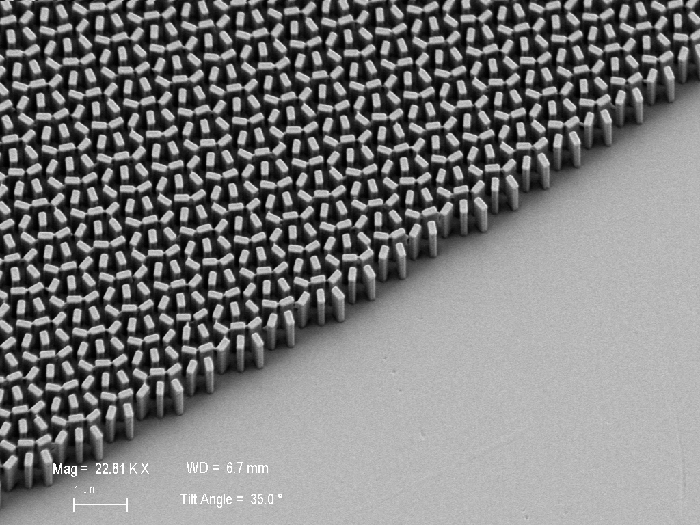Metalens technology is revolutionizing the way we think about optics in consumer electronics. Developed through years of research at Harvard, this innovative mini-lens system utilizes optical metasurfaces to bend light in unprecedented ways, making traditional bulky lenses a thing of the past. With the leadership of Rob Devlin at Metalenz, this technology has transitioned from the lab to a commercial powerhouse, producing millions of these advanced lenses for devices like the iPad and Samsung Galaxy S23 Ultra. The application of polarization technology in this field further enhances the functionality of smartphones, providing unique solutions for facial recognition and augmented reality. As Metalenz continues to lead with this exciting advancement, it paves the way for a new era of compact and efficient optical components.
The cutting-edge field of metalens innovation represents a significant breakthrough in optical technology, redefining the possibilities of optical metasurfaces. These minuscule lenses, which harness the principles of light manipulation at the nanometer scale, have the potential to transform various industries, particularly in consumer electronics. By integrating miniaturized lens systems into everyday devices, manufacturers can overcome the limitations posed by traditional lens designs. Polarization technology further enriches the capabilities of these advanced lenses, promising enhanced security features and improved imaging capabilities. As we explore the manifold applications of this groundbreaking technology, its impact on modern devices becomes increasingly pronounced.
The Rise of Metalens Technology
Metalens technology represents a groundbreaking advancement in optics, which is revolutionizing how we interact with consumer electronics. Designed at Harvard, these ultra-thin lenses—comprised of myriad tiny pillars—offer a remarkable ability to manipulate light, a capability traditionally reserved for bulkier, more expensive glass lenses. Thanks to Rob Devlin and the capabilities of Metalenz, this technology is now being mass-produced and integrated into popular devices like smartphones and tablets, indicating a significant shift in lens manufacturing practices.
The simplicity of production serves to lower costs substantially, making metalenes accessible across a wider range of consumer products. By harnessing semiconductor fabrication techniques that already dominate the tech industry, Metalenz could produce these innovative mini-lenses at scale, ensuring they meet the demands of rapidly growing markets. As noted by experts, this disruption of conventional lens-making practices not only enhances functionality but creates opportunities for entirely new industries based on meta-optical devices.
Innovative Applications of Mini-Lenses in Consumer Electronics
Mini-lens innovation is not just changing optics; it’s redefining the potential of consumer technology. For instance, the integration of Metalenz’s light-focusing metasurfaces into devices can enhance functionalities like facial recognition and augmented reality, making them faster and more accurate. With traditional lenses being a limiting factor in design and performance, the advent of mini-lenses has allowed tech companies to innovate freely, creating sleeker, more powerful devices.
The application of this technology is evident in products like the iPad and Google’s Pixel 8 Pro, proving that mini-lenses are now staples of modern technology. As Rob Devlin emphasizes, desktops and handheld devices with superior sensor capabilities are possible because of the compact and efficient nature of metalenses. This shift not only benefits tech manufacturers but also enhances user experiences, offering features that were previously too expensive or physically impractical.
Understanding Optical Metasurfaces and Their Impact
Optical metasurfaces are a significant leap forward in optical technology, relying on nanostructuring to control light manipulation effectively. By employing these ultra-thin materials, engineers like Rob Devlin at Metalenz are pushing the boundaries of what’s possible in optics, transcending the limitations of traditional lenses. This technology allows for precise control over light paths, drastically improving the performance of optical devices while minimizing their size.
The implications of this technological revolution extend beyond mere convenience. With the capability to design surfaces that can bend, focus, and manipulate light in dynamic ways, optical metasurfaces open doors to future applications, such as advanced imaging systems in smartphones and improved sensor technologies. Thus, the ongoing research and development in this field promise to deliver revolutionary products capable of transforming industries.
The Role of Rob Devlin at Metalenz
Rob Devlin, a pivotal figure in the launch and success of Metalenz, embodies the spirit of innovation cultivated in academic environments. His journey from working in Federico Capasso’s lab to leading a cutting-edge startup speaks volumes about the transformative power of collaborative research. Under Devlin’s leadership, Metalenz has rapidly scaled production and developed applications for its technology that were once considered the stuff of science fiction.
His focus on combining robust scientific knowledge with practical application has been crucial to the company’s growth. Devlin’s insights into material science and nanofabrication have resulted in a product that competes on the global stage while still being rooted in high-level academic research. The continued relationship between Metalenz and Harvard ensures a steady stream of innovation, allowing the company to maintain its competitive edge in the rapidly evolving tech landscape.
Disrupting Conventional Lens-Making Industries
The advent of metasurfaces marks a disruptive moment in the lens-making industry, traditionally dominated by bulky glass and plastic components. Companies that depend on these conventional methods are now challenged by the innovative breakthroughs offered by Metalenz’s mini-lenses. By providing a solution that significantly reduces size and manufacturing costs while enhancing performance, Metalenz is reshaping the competitive landscape of optical technologies.
This shift not only spurs innovation within the lens manufacturing sector but also introduces new market dynamics, urging competitors to adapt quickly. As Devlin points out, engaging with research institutions and continuously improving their product line is vital for staying ahead. This responsive approach ensures that Metalenz can cultivate new functionalities while capitalizing on the advantages of metasurface technologies.
The Future of Polarization Technology
Polarization technology is set to redefine security measures in consumer electronics, particularly in smartphone applications. Metalenz’s new Polar ID system utilizes light polarization to create a unique identification signature for users. This revolutionary approach not only enhances security but significantly decreases the size and cost compared to traditional polarization cameras, making the technology accessible to a broader audience.
Rob Devlin’s vision encompasses not just functional improvements in smartphones, but also applications across different disciplines such as healthcare and environmental monitoring. For instance, polarization technology could assist in identifying skin diseases, paving the way for innovative diagnostic tools. The adaptability of these technologies suggests a promising future where polarization applications will proliferate, transcending their initial boundaries.
Collaboration Between Academia and Industry
The collaborative environment between Harvard and Metalenz exemplifies how academic research can serve as a springboard for industrial innovation. With faculty members like Federico Capasso actively participating in product development, startups can leverage extensive academic knowledge to enhance practical applications. This synergy allows fresh ideas and technologies to reach commercialization quickly, ultimately benefiting consumers and the industry alike.
Such collaborations encourage knowledge transfer and create a culture of entrepreneurship within educational institutions. By fostering partnerships between researchers and industry leaders, new avenues for technological advancements can emerge, leading to the development of groundbreaking products that reshape the market landscape. Metalenz stands as a testament to this ideal, merging theoretical research with industry demands to deliver pioneering optical solutions.
Scaling Up with Metalenz Production
Metalenz’s ability to scale production seamlessly speaks to the efficiency of its mini-lens manufacturing methods. By partnering with established semiconductor foundries that produce chips at an astounding rate, Metalenz can meet the global demand for its optical devices. This operational efficiency not only keeps costs down but also ensures that the technology reaches consumers rapidly and at a competitive price.
Scaling production effectively is essential for sustaining growth and adapting to the rapid changes in consumer electronics. As more devices integrate optical metasurfaces, maintaining the balance between innovation and manufacturing will be paramount. Metalenz’s strategy hinges on refining existing products while exploring further technological enhancements, solidifying its place within a fast-evolving market landscape.
The Challenges and Opportunities Ahead for Metalenz
As Metalenz forges ahead in the competitive landscape of optical technologies, it faces both challenges and opportunities. The rapid pace of innovation in the tech industry means that maintaining a leading position requires continuous research and adaptability. Competitors are likely to emerge as the technology gains recognition, leading to increased market pressures.
However, with the foundational advantages of its unique mini-lens technology, Metalenz is well-positioned to leverage its early successes and expand its product line. Focusing on refining their existing metasurfaces while simultaneously addressing emerging demands will be key to navigating future challenges. In an industry where technological advancements occur at breakneck speed, Metalenz’s proactive approach will be crucial for sustained success.
Frequently Asked Questions
What is metalens technology and how does it differ from traditional lenses?
Metalens technology refers to the use of optical metasurfaces to manipulate light at a microscale using tiny pillars on a wafer. Unlike traditional lenses, which rely on curved glass or plastic to focus light, metalenses are thinner, lighter, and can be mass-produced, providing a cost-effective solution for consumer electronics.
How is Metalenz revolutionizing consumer electronics with mini-lens innovations?
Metalenz is revolutionizing consumer electronics by producing mini-lens innovations that utilize metalens technology, allowing for high-performance optical devices to fit into sleek designs. Their metasurfaces have been integrated into products like the iPad and Galaxy S23 Ultra, enhancing functionalities such as 3D sensing and camera capabilities.
What are the applications of optical metasurfaces in technology today?
Optical metasurfaces, as developed by Metalenz, are used in various applications today, including 3D sensing for facial recognition and augmented reality, as well as in enhancing camera performance in smartphones. These innovations enable manufacturers to pack advanced features into increasingly compact devices.
Who are the key figures behind the development of metalens technology?
Key figures in the development of metalens technology include Rob Devlin, CEO of Metalenz, and Federico Capasso, the Robert L. Wallace Professor of Applied Physics at Harvard. Their collaborative efforts in research and development have paved the way for the commercialization and mass production of meta-lenses.
How does polarization technology enhance the functionality of metalenses?
Polarization technology enhances metalenses’ functionality by allowing them to capture unique light signatures, which provides additional security features for smartphones and aids in applications like skin cancer detection and air quality monitoring. The new Polar ID system developed by Metalenz exemplifies this application.
What is the significance of collaboration between academia and startups like Metalenz?
The collaboration between academia and startups like Metalenz is crucial for translating groundbreaking research into commercially viable technologies. Such partnerships leverage scientific advancements from university labs to innovate and create new industries, as seen with the evolution of metalens technology from research at Harvard into mass-market products.
What future advancements can be expected from Metalenz in optical metasurfaces?
Future advancements from Metalenz in optical metasurfaces may include further miniaturization and cost reduction of devices, as well as innovative applications of polarization technology, such as in security and medical diagnostics, all of which leverage the unique capabilities of metasurfaces.
What challenges does Metalenz face in the competitive optical industry?
Metalenz faces challenges in maintaining its competitive edge in the rapidly evolving optical industry. To combat this, the company focuses on continuous improvement of existing products and innovation of new technologies, ensuring they remain at the forefront of metalens technology and its applications.
How does Metalenz ensure the mass production of its optical metasurfaces?
Metalenz ensures the mass production of its optical metasurfaces by collaborating with large semiconductor foundries that have the capacity to manufacture over a trillion chips annually. This partnership allows for the efficient scaling of production to meet growing demand in consumer electronics.
| Key Point | Details |
|---|---|
| Origin of Metalens Technology | Developed in the Capasso lab at Harvard, utilizing tiny pillars on a wafer to bend light. |
| Mass Production | Metalenz produces millions of metasurfaces for consumer electronics and is mass-producing them using semiconductor chip foundries. |
| Applications | Integrated into devices like iPads and smartphones for advanced features, such as depth sensing and facial recognition. |
| Future Developments | New technologies like Polar ID aim to enhance security in smartphones at a fraction of traditional costs. |
| Innovation Impact | Metalenz is poised to disrupt the conventional lens-making industry by offering smaller, cheaper alternatives. |
Summary
Metalens technology is revolutionizing the optics industry by providing smaller, more efficient alternatives to traditional lenses. Developed in a groundbreaking research environment at Harvard, Metalenz is now a leading player in the market, creating innovative products that are being adopted by major consumer electronics. As the demand for compact and advanced optical systems continues to grow, this technology represents a significant leap forward, enabling a wide range of applications in devices around the world.





